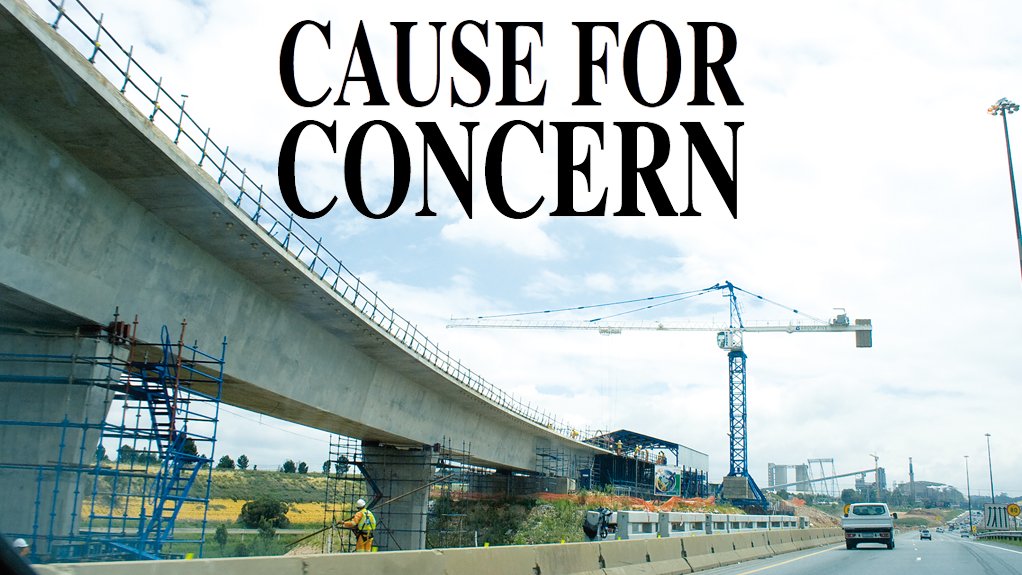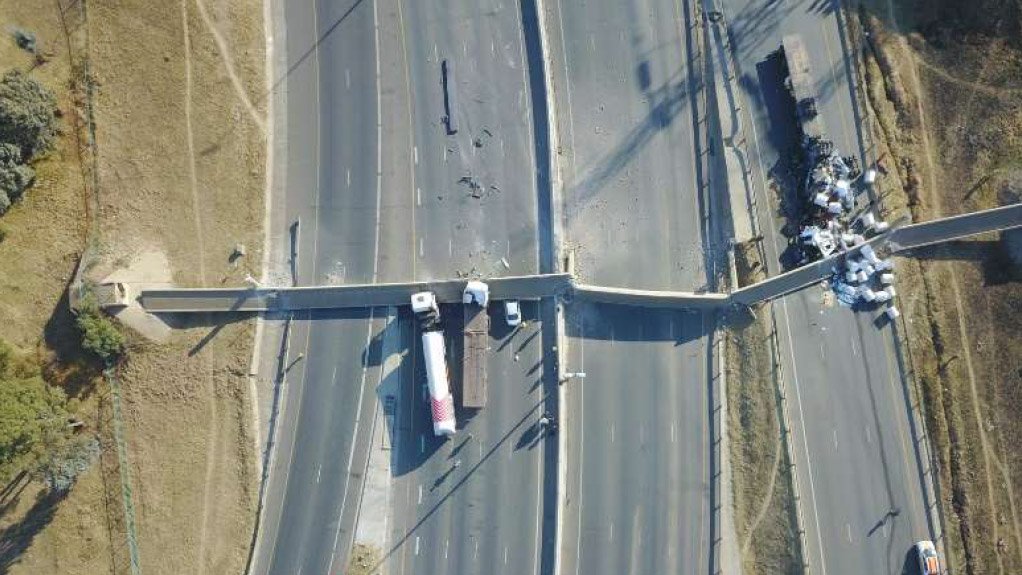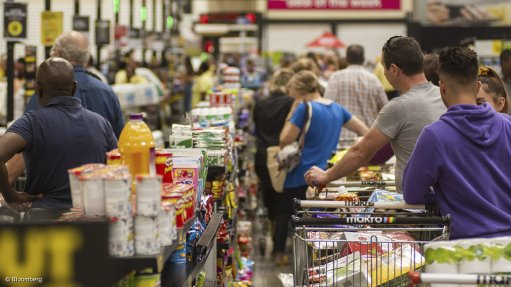Mixed picture emerges of state of SA’s road bridges following deadly Genoa collapse



STATISTICAL ANOMALY A full inspection of the N3 pedestrian bridge had been done in July 2016, with no defects of any significance being noted
Photo by Sanral
In light of the highly publicised Genoa bridge collapse, in Italy, as well as the abrupt closure of Johannesburg’s M2 east highway, questions surrounding the structural integrity of South African bridges have been raised.
Bridges that fall within the South African National Road Agency Limited’s (Sanral’s) ambit are in good condition, but those under the auspices of provincial or local government tend to vary from being in good condition to very poor condition.
Sanral bridge network manager Edwin Kruger notes that, in the 2017/18 financial year, the national road system comprised 9 874 bridges and major culverts, which are inspected every five to six years by accredited inspectors. This figure includes the 927 bridges and culverts on routes managed by concession holders.
The commentary associated with Sanral’s 2017/18 financial results indicates that 93% of travel on national roads involved bridges considered to be in good condition. “This was slightly lower than in 2016/17, when the figure was 94%,” comments Kruger.
Sanral civil structural engineer Abongile Nyokana notes that the majority of the national bridges and culverts were inspected from 2015 to 2017. “Wherever road upgrades include new bridges and culverts, inspectors ensure that these structures meet the specified flood-capacity standards.”
Kruger notes that, unlike roads, bridges generally have a longer design life and, as such, “the pressure to delay bridge repairs in budgets is evident”.
Municipalities and provincial governments frequently struggle to balance their budgets, with 31% of all municipalities “dysfunctional or distressed” and a further 31% nearing a dysfunctional state, according to Cooperative Governance and Traditional Affairs Minister Dr Zweli Mkhize.
It is perhaps unsurprising that some bridges under municipal or provincial discretion are in very poor condition.
Provincial Breakdown
The Northern Cape Department of Roads and Public Works’ 2016/17 results state that “the technical needs determined for the provincial road network amount to R8.6-billion” and, of that, R1.3-billion is required for rehabilitation.
The department notes that 371 bridges were inspected from 2012 to 2015 and “indicate an ageing bridge stock, with large backlogs of urgent repair and maintenance needs”.
Overall, bridges are in a fair condition, but most show some form of deterioration, with the department requiring R38-million for bridge maintenance and R136-million for critical repair.
The Western Cape Department of Public Works’ 2016/17 results indicate that it completed the targeted construction of six out of seven bridges, and rehabilitated 22 bridges, exceeding its target of 11.
The Western Cape government spent R1-billion on transport infrastructure “rehabilitation and renovation”, and R649-million on maintenance and repairs. The department states that an additional R2.86-billion a year is required to ensure that the network is maintained over the next ten years.
According to the Eastern Cape Depart- ment of Public Works’ 2016/17 results, the department achieved 64% of its targets for “network planning, construction and maintenance”, using 99% of its budget.
“At current funding levels, the roads infrastructure backlog is likely to increase. The province is faced with capital and maintenance backlogs,” it notes.
The results further indicate that only about R12-million of its budget was spent on transport infrastructure, with R282-million spent on administration programmes.
According to the North West Department of Public Works and Roads’ 2016/17 results, the department managed to complete the construction of one of two planned bridges, and managed to repair two bridges. The department reportedly spent R419-million of the R421-million allocated for transport infrastructure maintenance.
The KwaZulu-Natal Department of Transport’s 2016/17 results note that it plans to construct 65 bridges before 2020. During the period under review, the department started construction of 13 vehicle bridges and four pedestrian bridges. The department spent R3.5-billion and R3.2-billion on infrastructure construction and maintenance respectively.
The Mpumalanga Department of Public Works, Roads and Transport’s 2016/17 results note that, during the period, it repaired one flood-damaged bridge and constructed two new bridges. About R906-million was appropriated for maintenance, but this amount was exceeded by about R327-million (to about R1.12-billion), some of which was reappropriated from the department’s construction allocation.
The Gauteng Department of Roads and Transport’s 2016/17 results note that 70% of the province’s road network is in good condition. It spent R1-billion on road maintenance and repair.
The department notes that designs for the repair and maintenance of eight bridges in Tshwane were completed in 2016/17. A bridge repair project in Nancefield was delayed, owing to “community unrest and subsequent stoppages”. This bridge has been closed periodically ever since, owing to unsafe conditions caused by flooding.
The Free State Department of Police, Roads and Transport completed maintenance on the Oranjeville bridge, and started repairs for flood damage, including damage to bridge structures, its 2016/17 report notes. A total of R923-million of the R1.6-billion transport infrastructure allocation was spent on maintenance.
Ultimately, the provincial situation can be summarised by the Limpopo Department of Public Works, Transport, Roads and Infrastructure’s 2016/17 report: “The paved network has served its life and is ageing . . . insufficient maintenance, coupled with adverse weather . . . and increased traffic volumes, [is] the main contributor to the increased rate of deterioration . . . with the current budget allocation, the department will not be able to address the existing backlog [or] maintain its current surfaced and gravel network.”
M2 East Bridge Rehabilitation
A total of 94% of the bridges in the Johannesburg region require immediate intervention, notes Johannesburg Roads Agency (JRA) engineer Thomas Chongo.
In August, following the closure of the M2 east highway over the Karsene bridge – owing to a failed bridge deck support, as well as cracks to the structure – Johan- nesburg mayor Herman Mashaba told the media that the city had a R170-billion infrastructure backlog. Further, the city did not have the necessary funding to address the backlog.
The R70-million programme for the M2 east bridge rehabilitation is scheduled to start this month – once procurement has been finalised – and is expected to be completed in about 12 months. “Continued use could have led to serious loss of both life and property.”
Chongo notes that R135-million has been allocated to the JRA for the bridge programme.
The JRA investigated the state and quality of 814 of the 902 bridges in Johannesburg in 2014 and 2015. In December 2015, it announced that it would spend a total of R210-million to upgrade the M1 highway bridges, which formed part of a R365- million upgrade encompassing the M1, the M2 and the Soweto highway bridges.
The M1 project was supposed to be completed in 2017, but is still ongoing, having been plagued by delays caused by the main contractor. The JRA notes that, by the time the initial completion date of May 2017 lapsed, only 17% of the project had been completed.
The JRA’s 2017 ‘Roads Condition Index’ shows a 25% deterioration in the condition of the roads network, which has a maintenance backlog of R11.8-billion. It also states that 707 of the 902 bridges are either in poor or very poor condition.
From 2013 to 2017, 37 bridges collapsed during rainy seasons in Johannesburg. Meanwhile, in 2018, the JRA closed a portion of Peter road, in Ruimsig, owing to a collapsed culvert, while the Dorothy Nyembe pedestrian bridge, in Dobsonville, partially collapsed after flooding. The JRA also closed the Mzimhlophe pedestrian bridge, in Orlando East, owing to an “unstable and rapidly deteriorating structure”. However, Chongo notes, no full collapse has been recorded to date.
With regard to the other bridges in poor condition, Chongo notes that the JRA will work on them when funds are allocated. However, he assures the public that the JRA continually monitors the state of bridges that need repairs and, “should a bridge pose a threat to the safety of motorists and the community, the bridge will be closed”.
Despite its comparative effectiveness, Sanral has also recorded a bridge collapse in the past two years. On August 9, 2017, a pedestrian bridge collapsed onto the N3 highway. Kruger notes: “Fortunately, the collapse occurred on a public holiday and nobody was killed.”
While the bridge did not collapse onto any vehicles, three trucks and a car drove into the collapsed structure.
“The initial reaction of the public was that Sanral did not maintain the bridge,” Nyokana recounts. “However, a full inspection of the bridge had been done in July 2016, with no defects of any significance being noted by the accredited and appropriately qualified bridge inspector.”
Sanral appointed independent consultants to investigate the incident, and their report indicated that the collapse had been caused by an 8.1 t roll of steel, which had not been properly secured to a truck, hitting the pier at about 90 km/h. “Statistically, the accident was an extremely rare event,” notes Nyokana.
Kruger emphasises that “the point is the bridge had been inspected”.
Despite the overall good quality of the national roads network, including bridges, the South African Institution of Civil Engineering notes that road conditions in provinces remain precarious. In its third ‘Infrastructure Report Card for South Africa’, released last year, the organisation notes: “There is a risk of further deterioration, owing to vehicle overloading, poor maintenance and the reduction in skilled personnel in provincial departments.”
“A particular issue is the difficulty in [determining the extent to which] monitoring is conducted and, [if monitoring is done, the extent to which] this is used for effective asset management.”
Ultimately, national bridges and culverts that would have been inspected in the past six years are, in all likelihood, structurally safe, although the same cannot be definitively stated for provincial, metropolitan and municipal bridges.
Comments
Announcements
What's On
Subscribe to improve your user experience...
Option 1 (equivalent of R125 a month):
Receive a weekly copy of Creamer Media's Engineering News & Mining Weekly magazine
(print copy for those in South Africa and e-magazine for those outside of South Africa)
Receive daily email newsletters
Access to full search results
Access archive of magazine back copies
Access to Projects in Progress
Access to ONE Research Report of your choice in PDF format
Option 2 (equivalent of R375 a month):
All benefits from Option 1
PLUS
Access to Creamer Media's Research Channel Africa for ALL Research Reports, in PDF format, on various industrial and mining sectors
including Electricity; Water; Energy Transition; Hydrogen; Roads, Rail and Ports; Coal; Gold; Platinum; Battery Metals; etc.
Already a subscriber?
Forgotten your password?
Receive weekly copy of Creamer Media's Engineering News & Mining Weekly magazine (print copy for those in South Africa and e-magazine for those outside of South Africa)
➕
Recieve daily email newsletters
➕
Access to full search results
➕
Access archive of magazine back copies
➕
Access to Projects in Progress
➕
Access to ONE Research Report of your choice in PDF format
RESEARCH CHANNEL AFRICA
R4500 (equivalent of R375 a month)
SUBSCRIBEAll benefits from Option 1
➕
Access to Creamer Media's Research Channel Africa for ALL Research Reports on various industrial and mining sectors, in PDF format, including on:
Electricity
➕
Water
➕
Energy Transition
➕
Hydrogen
➕
Roads, Rail and Ports
➕
Coal
➕
Gold
➕
Platinum
➕
Battery Metals
➕
etc.
Receive all benefits from Option 1 or Option 2 delivered to numerous people at your company
➕
Multiple User names and Passwords for simultaneous log-ins
➕
Intranet integration access to all in your organisation




















